
- Home
- Travel Packages
- Top Destination
-
Travel Attraction
By Category
Top Attraction

- Travel Agents
- Car Rentals
- Hotels
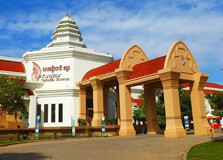
Siem Reap, located in northwestern Cambodia, is a vibrant city known primarily for its proximity to the world-famous Angkor Archaeological Park, home to the iconic Angkor Wat temple. The city serves as the gateway for tourists visiting the ancient ruins, making it one of Cambodia’s top tourist destinations. Siem Reap is a charming blend of history, culture, and modernity, with colonial-era architecture, bustling markets, and vibrant nightlife. Angkor Wat, the largest religious monument in the world, is the centerpiece of the Angkor complex, and its stunning beauty attracts millions of visitors annually. In addition to Angkor Wat, Siem Reap offers other remarkable temples such as Bayon Temple and Ta Prohm, known for its fascinating tree-root overgrowths. The city itself boasts a variety of attractions, from the lively Pub Street with its array of restaurants, bars, and shops, to the serene Tonle Sap Lake, which is known for its floating villages. Siem Reap also offers cultural experiences, such as traditional Apsara dance performances and handicraft markets. With modern hotels, restaurants, and a growing expat community, Siem Reap has become a hub for both tourists and locals. The city’s mix of historical significance and modern amenities makes it a captivating destination in Southeast Asia.
Explore More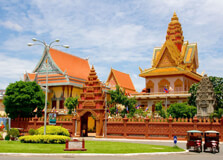
Phnom Penh, the capital city of Cambodia, is a bustling metropolis that blends rich history with modern development. Situated on the banks of the Tonle Sap, Mekong, and Bassac rivers, the city serves as the political, cultural, and economic heart of the country. Phnom Penh’s historical significance is evident in its colonial architecture, vibrant markets, and cultural landmarks. The Royal Palace, with its stunning Silver Pagoda, is one of the city’s most iconic attractions. Visitors also flock to the National Museum, which showcases Cambodia’s rich history and ancient artifacts, and the Tuol Sleng Genocide Museum, a sobering reminder of the Khmer Rouge regime. The Killing Fields, just outside the city, are another haunting yet important historical site. Despite its turbulent past, Phnom Penh has undergone significant modernization, with a growing skyline, shopping malls, and an emerging food scene. The city offers a variety of dining options, from traditional Khmer cuisine to international flavors, and a lively nightlife with rooftop bars and cafes. Phnom Penh’s charm lies in its juxtaposition of old and new—where ancient temples stand alongside modern skyscrapers, and the past and present coexist, making it an intriguing and dynamic destination for travelers and locals alike.
Explore More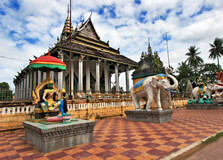
Battambang, located in northwestern Cambodia, is a charming and laid-back city known for its colonial architecture, scenic countryside, and rich cultural heritage. Often overlooked by tourists compared to Siem Reap and Phnom Penh, Battambang offers a more relaxed atmosphere and a glimpse into authentic Cambodian life. The city is famous for its French colonial-era buildings, which add character to its streets, and for its proximity to several significant temples and historical sites. Wat Ek Phnom, a 11th-century Hindu temple, and the ancient Phnom Banan Temple, perched atop a hill with panoramic views, are popular attractions for history enthusiasts. Battambang is also known for its picturesque surroundings. The countryside is dotted with rice paddies, traditional villages, and bamboo forests, making it ideal for cycling tours. One of the most unique experiences is the "Bamboo Train," a makeshift, open-air train that runs through the countryside, offering an unforgettable ride through rural Cambodia. The city has a burgeoning arts scene, with local galleries and cultural performances highlighting traditional Cambodian music, dance, and art. Battambang’s food scene is also notable, with fresh, local ingredients and Khmer delicacies offering a taste of the region’s culinary traditions. It’s a peaceful, off-the-beaten-path destination for those looking to explore Cambodia beyond its major tourist hubs.
Explore More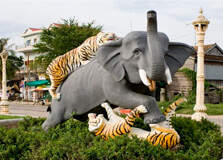
Kampong Thom, located in central Cambodia, is a quiet and picturesque province that serves as a gateway to some of the country’s most important archaeological sites. Situated along the banks of the Stung Sen River, the town itself is known for its rural charm, making it an ideal destination for those seeking to experience the Cambodian countryside. One of Kampong Thom’s main attractions is the Sambor Prei Kuk temple complex, a UNESCO World Heritage site that dates back to the 7th century. This ancient Khmer site, filled with stunning brick temples and hidden in a forested area, offers a more tranquil alternative to the more crowded Angkor ruins in Siem Reap. The province is also home to other historical sites, including the Preah Theat Temple and the ancient town of Isanapura. Kampong Thom is also known for its rich agricultural land, producing rice, rubber, and a variety of fruits. The local markets offer a vibrant display of fresh produce, handicrafts, and traditional Khmer goods. Visitors can explore the rural landscape by cycling or visiting nearby villages, where they can observe traditional farming methods and rural life. For those looking to escape the bustling cities, Kampong Thom offers a peaceful, cultural retreat with both historical significance and natural beauty.
Explore More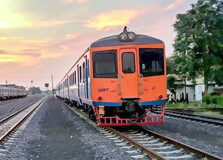
Poipet, located in the western part of Cambodia, is a border town known for its strategic location as a gateway between Cambodia and Thailand. Situated in Banteay Meanchey Province, Poipet is a key crossing point for travelers and goods moving between the two countries. The town's proximity to Thailand makes it a bustling hub for commerce, with a strong presence of markets, casinos, and border trade. Poipet is often associated with its lively border trade, which includes various goods like textiles, electronics, and food. The town is home to several casinos, drawing both Cambodian and international visitors looking for entertainment. While the casinos are a major draw, Poipet’s charm lies in its vibrant, cross-cultural atmosphere, blending Thai and Cambodian influences. For those seeking cultural or historical experiences, Poipet offers access to nearby temples and rural landscapes. The town's outskirts are dotted with rice fields and traditional villages, giving visitors a glimpse into the more rural side of Cambodia. Although Poipet is often viewed as a transit point, it offers a unique experience for travelers passing through, with opportunities to explore local markets, enjoy the border town vibe, and discover nearby natural attractions. It’s an intriguing destination for those traveling between Cambodia and Thailand.
Explore More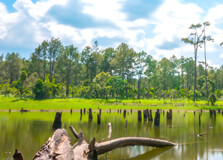
Koh Kong, located in southwestern Cambodia, is a coastal province known for its lush landscapes, pristine beaches, and rich biodiversity. Situated along the Gulf of Thailand, it is one of the country’s most scenic and least developed regions, offering a tranquil escape for nature lovers and adventure seekers. The province is famous for its beautiful natural attractions, including the Cardamom Mountains, a vast range of tropical forests and wildlife sanctuaries. This area is a haven for eco-tourism, offering trekking, wildlife viewing, and river cruises. Koh Kong is also home to several islands, such as Koh Kong Island and the nearby Koh Sdach (King's Island), which feature unspoiled beaches, crystal-clear waters, and excellent opportunities for diving, snorkeling, and fishing. In addition to its natural beauty, Koh Kong is known for its role in Cambodia’s growing eco-tourism industry. The province offers eco-lodges and community-based tourism projects that focus on preserving the environment and benefiting local communities. Visitors can explore local fishing villages, enjoy fresh seafood, or relax by the serene beaches. Koh Kong is also a gateway to Thailand, with a border crossing to the Thai province of Trat, making it an important trade and travel route. This peaceful and relatively undiscovered destination is ideal for those looking to explore Cambodia's natural wonders and enjoy a slower pace of life.
Explore More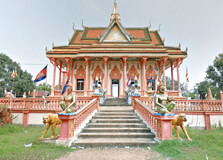
Stung Treng, located in northeastern Cambodia, is a quiet and scenic province known for its natural beauty, rivers, and remote landscapes. Situated along the banks of the Mekong River, it serves as both a gateway to Laos and an important stop for travelers exploring Cambodia's lesser-known regions. Stung Treng offers a peaceful, off-the-beaten-path experience for those looking to escape the crowds of more popular tourist destinations. The province is home to lush forests, wetlands, and abundant wildlife, making it a haven for nature lovers and eco-tourism. One of the main attractions is the Mekong River's rare Irrawaddy dolphin population, which can be seen in the river’s deep pools. The region also boasts various waterfalls, such as the powerful Phnom Yat Waterfall, and pristine natural reserves, including the Stung Treng Wildlife Sanctuary. Stung Treng is also culturally significant, with a mix of indigenous and Khmer communities residing in the area. Visitors can explore local villages, where they can witness traditional fishing techniques and enjoy the hospitality of the rural Cambodians. The town itself is small but bustling, with a range of guesthouses, markets, and eateries catering to travelers. Stung Treng is an ideal destination for those seeking a slower pace of life, natural beauty, and authentic cultural experiences in Cambodia’s less explored corners.
Explore More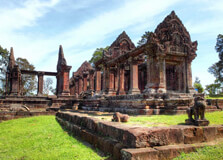
Kratie, located in northeastern Cambodia, is a tranquil town set along the banks of the mighty Mekong River. Known for its serene rural atmosphere and scenic beauty, Kratie offers visitors an authentic glimpse into rural Cambodian life, far from the bustling tourist hubs. The town is particularly famous for its population of rare Irrawaddy dolphins, which can be spotted in the Mekong River, making it a prime destination for eco-tourism and wildlife enthusiasts. One of the key attractions in Kratie is the Mekong River's "Dolphin Pools," where visitors can take boat tours to observe these endangered freshwater dolphins in their natural habitat. The province is also home to beautiful landscapes, including lush green rice paddies and picturesque countryside, perfect for cycling or river cruises. Kratie is rich in culture and history, with several ancient temples and pagodas, such as Wat Rokar Khnor, providing a glimpse into the region’s Buddhist heritage. The nearby 16th-century French colonial-style architecture adds to the town's charm. With its peaceful environment, Kratie offers an ideal escape for travelers looking to experience authentic Cambodian life, immerse in nature, and enjoy quiet reflection by the Mekong. It’s a perfect destination for those seeking relaxation, wildlife experiences, and a taste of Cambodia’s rural beauty.
Explore More9N Impressive Vietnam - Cambodia Tour
10 Days/ 9 Night
Siem Reap - Phnom Penh - Ho Chi Minh City - Ha Long - Hanoi
9 Nights - 10 Days Vietnam - Cambodia Package
10 Days/ 9 Night
Siem Reap - Phnom Penh - Ho Chi Minh City - Hanoi
Explore The World 6 Nights - 7 Days Tour Package
7 Days/ 6 Night
Bangkok - Pattaya - Siem Reap
Explore The Beauty Cambodia 4N 5D Tour
5 Days/ 4 Night
Siem Reap - Phnom Penh
Cambodia is situated in Southeast Asia, in the Indochina peninsula. It is officially known as the Kingdom of Cambodia. The ancient name of Cambodia was Kambuja. The national parks, waterfalls, ancient ruins, and sites of ancient civilizations are the major tourist attractions of Cambodia. It is a treasure-island for those who are adventurous at heart. The Angkor Archaeological Park, Bokor National Park, Kompong Thom, Kratie, etc. are some of the destinations which define Cambodian Tourism. The Temple of Angkor Wat is popular all over the world and the Angkor Archaeological Park has been designated as a UNESCO World Heritage Site.
Riel (KHR)
181,035 square km (69,898 square miles)
14,952,665 (estimated)
Khmer
+855
(UTC+7)
The Monsoons dominate the climate of the Cambodia. There are two seasons of Cambodia: The rainy and dry season. The period between November to April forms the dry season when the temperatures reach 40 degrees Celsius (104 degrees F) and the period between May to October forms the rainy season when the temperatures dip to 22 degrees Celsius.
To the northwest of Cambodia lies Thailand, to the northeast lies Laos, to the east is Vietnam and to the southwest is the Gulf of Thailand. Cambodia is located between latitudes 10 degrees and 15 degrees N and longitudes 102 degrees and 108 degrees E. Vietnam’s coastline runs a distance of 443 kilometers along the Gulf of Thailand.
Territory & Capital : The terrain of Cambodia is marked by plains, uplands, low mountains and the Mekong River Delta. The plains of Cambodia have thinly wooded forests while the coastal areas are covered with dense forests. The highest point of Cambodia is measured at 5,949 feet (1,813 meters). The lakes of Cambodia expand to great extents during the rainy seasons.
Suitable Visiting Seasons : The best time to visit Cambodia is the period between October and December when the temperature is cool and averages between 24 degrees C and 26 degrees C.
The waterways and roadways serve as the prominent means of transport in Cambodia. The airports are also used for coming into and going out of Cambodia. The railways of Cambodia are being improved and fast becoming the preferred mode of transport to travel across the country.
Contact the nearest Cambodian embassy for updated details on the process of obtaining Visas for Cambodia.